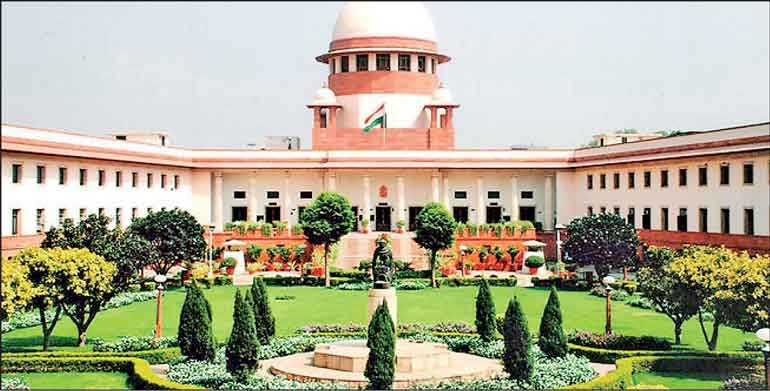Monday Mar 17, 2025
Monday Mar 17, 2025
Saturday, 30 January 2021 00:04 - - {{hitsCtrl.values.hits}}

Marking the occasion of the first sitting under a new Constitution on 28 January, the Supreme Court though a press release said that the institution had relentlessly marched towards ensuring the protection of the rights and liberties of the citizens, upholding rule of law and constitutional values amidst various challenges
By Vinod K. Jacob
The first sitting of the Supreme Court of India under the new Constitution was held on 28 January 1950, just two days after the country became a republic. The inaugural session took place at the stately Chamber of Princes where the highest court of the land had sit for 12 years between 1937 and 1950 as the Federal Court of India. Initially the Supreme Court of India functioned from the Parliament House till it shifted in 1958 to its current location at Tilak Marg, New Delhi.
When the Indian Constitution was adopted in 1950, it provided for a Supreme Court with a Chief Justice (Justice Sir Harilal Jekisundas Kania was the Chief Justice at the inaugural sitting on 28 January 1950) and seven puisne judges. It was up to the new Parliament of India to increase the numbers which rose to 11 in 1956, 14 in 1960, 18 in 1978, and 26 in 1986. At present the highest court comprises the Chief Justice and 30 other judges appointed by the President of India. The judges of the Supreme Court of India retire upon attaining the age of 65 years.
The Indian Constitution has enshrined the principle of the independence of the Judiciary. A judge of the Supreme Court cannot be removed from office except by an order of the President passed after an address in each house of Parliament supported by a majority of the total membership of that House and by a majority of not less than two thirds members present and voting and presented to the President in the same session for such removal on the ground of proved misbehaviour or incapacity. A person who has been a judge of the Supreme Court is debarred from practicing in any court of law or before any other authority in India.
Besides being the highest constitutional court which can be approached directly by any Indian citizen under Article 32 on fundamental rights matters, the Supreme Court is also the highest court of appeal in the land. While deciding cases, the Supreme Court is called upon to interpret the Constitution, solve inter-state disputes and address other important questions of law.
Over time it has been a pioneer among the judicial systems of the world especially in areas such as environmental jurisprudence, public interest litigation and protecting the interests of the poor and the disadvantaged. At present an Indian judge from the Supreme Court, Justice Dalveer Bhandari is also serving as member of the International Court of Justice at The Hague.
As of 1 January 2021, there were 65,086 pending matters in the Supreme Court of India, of which there were 45,866 admission matters and 19,220 regular hearing matters. Marking the occasion of the first sitting under a new Constitution on 28 January, the Supreme Court though a press release said that the institution had relentlessly marched towards ensuring the protection of the rights and liberties of the citizens, upholding rule of law and constitutional values amidst various challenges.
Despite COVID-19 virus infection, the Supreme Court of India worked much beyond the usual minimum of 190 days of sitting in a calendar year. The Supreme Court registry remained functional for 271 days as against an average of 268 days in the previous three years. A total of 43,713 hearings were held by 1998 benches though video conference till 31 December despite technological constraints, pandemic protocols and reduced work force.
(The writer is the Deputy High Commissioner of India to Sri Lanka since September 2019.)
Discover Kapruka, the leading online shopping platform in Sri Lanka, where you can conveniently send Gifts and Flowers to your loved ones for any event including Valentine ’s Day. Explore a wide range of popular Shopping Categories on Kapruka, including Toys, Groceries, Electronics, Birthday Cakes, Fruits, Chocolates, Flower Bouquets, Clothing, Watches, Lingerie, Gift Sets and Jewellery. Also if you’re interested in selling with Kapruka, Partner Central by Kapruka is the best solution to start with. Moreover, through Kapruka Global Shop, you can also enjoy the convenience of purchasing products from renowned platforms like Amazon and eBay and have them delivered to Sri Lanka.
Discover Kapruka, the leading online shopping platform in Sri Lanka, where you can conveniently send Gifts and Flowers to your loved ones for any event including Valentine ’s Day. Explore a wide range of popular Shopping Categories on Kapruka, including Toys, Groceries, Electronics, Birthday Cakes, Fruits, Chocolates, Flower Bouquets, Clothing, Watches, Lingerie, Gift Sets and Jewellery. Also if you’re interested in selling with Kapruka, Partner Central by Kapruka is the best solution to start with. Moreover, through Kapruka Global Shop, you can also enjoy the convenience of purchasing products from renowned platforms like Amazon and eBay and have them delivered to Sri Lanka.